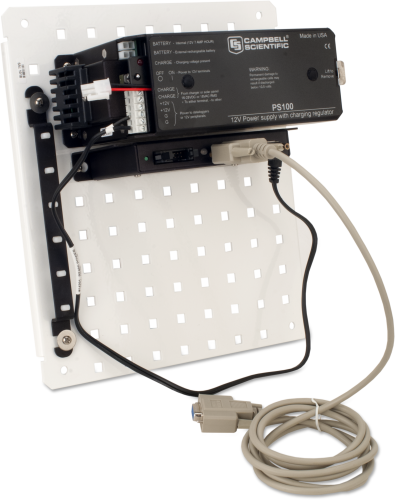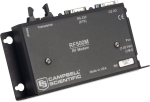This product is not available for new orders.

| Services Available | |
|---|---|
| Repair | No |
| Free Support | Yes |
Overview
The RF500B base station resides at the computer site and serves as a link between field stations and repeater stations. It includes an RF500M radio modem connected to a PS150 power supply. The modem and power supply are then mounted to a 10 inch by 12 inch metal plate.
The radio, antenna, antenna cable, and wall charger need to be ordered separately. Compatible radios include our RF320 series, our RF310 series, our RF300 series, and the DataRadio DL-3400. Software support is provided by LoggerNet.
Read MoreBenefits and Features
- Includes the RF500M RF modem and PS150 power supply mounted to a metal plate
- Supports multiple radio configurations
- Uses software (DevConfig) instead of hardware modifications to upgrade the operating system (OS) and change RF ID or other settings
- Provides an RS-232 port (DTE) for modem configuration or attachment of an RS-232 radio
- Avoids all collisions within a network, thus increasing polling speeds and reducing overall current drain
Images




Detailed Description
The RF500B provides the PS150 power suppl, RF500M modem, 18657 DB9-female null-modem cable (beige cable), 14291 field power cable (black cable), and a 10-in. x 12-in. metal plate.
Operating System (OS) Options Descriptions
PakBus OS
Considered the standard for the RF500M, the -PB OS uses TDRF polling to quickly and efficiently move data through a network. Each station can be individually dialed by LoggerNet. This OS is compatible with -TD, -PB, and our current generation of PakBus data loggers.
ALERT Dual Mode OS
The ALERT (Automated Local Evaluation in Real Time) OS allows for transmission, repeating, and reception of binary ALERT formatted data. It is a derivative of the -PB OS, and therefore supports both ALERT and TDRF communications (allowing true two-way communication with a station). This OS is compatible with the CR200(X)-series, CR800-series, CR1000, and CR3000 dataloggers.
Dial OS
The dial OS works with both mixed-array and PakBus/table-based data loggers. Each station can be dialed by LoggerNet for downloading data, sending programs, and performing other tasks. Additionally, this OS allows stations to create point-to-point networks for sharing of measurement and control tasks.
Compatibility
Data Logger Considerations
Time division polling and PakBus communications can be used in the same network as long as all of the data loggers are PakBus versions.
Compatible Contemporary Data Loggers
| RF500B OS | CR200(X) Series | CR800/CR850 | CR1000 | CR3000 | CR9000X |
| -PB |  |
 |
 |
 |
|
| -DA |  |
 |
 |
||
| -AL |  |
 |
 |
 |
Compatible Retired Data Loggers
| RF500B OS | CR500 | CR510 | CR10 | CR10T | CR10X | 21X | CR23X |
| -PB | # |  |
# | # | |||
| -DA |  |
‡ |  |
‡ |  |
‡ | |
| -AL |
| RF500B OS | CR9000 | CR5000 | CR7X |
| -PB | |||
| -DA |  |
||
| -AL |
Notes:
#The -PB OS option for the RF500B is only compatible with the -PB and -TD OS for the CR510, CR10X, and CR23X.
‡The -DA OS option for the RF500B is NOT compatible with the -TD OS option for the CR510, CR10X, and CR23X.
Radios
Three jumper settings allow the RF500B to be used with a variety of radios. Though not a requirement, it is a good idea to standardize your network to use a single radio type. This practice simplifies operations and maintenance and provides the highest degree of interstation compatibility possible.
| RF320 Series | RF310 Series | RF300 Series | Calamp DataRadio DL-3400 |
Digital/ RS-232 Radio |
RF200 | RF100 |
 |
 |
 |
 |
† |
Note:
†The RF500B must have the -PB OS option to use a digital RS-232 radio with it.
Radio Modems and Radio Base Stations
Networks can contain a mixture of RF500B base station and other Campbell Scientific base stations and radio modems assuming they have compatible operating systems (see chart below).
| Modem/ Base Station |
-PB OS | -DA OS | -AL OS | |
| RF500M | -PB |  |
* | |
| -DA |  |
|||
| -AL |  |
|||
| RF500B | -PB |  |
* | |
| -DA |  |
|||
| -AL |  |
|||
| RF310M | -TD |  |
* | |
| -MA |  |
|||
| -AL |  |
|||
| RF310B | -TD |  |
* | |
| -MA |  |
|||
| -AL |  |
|||
| RF315M | -TD |  |
* | |
| -MA |  |
|||
| -AL |  |
|||
| RF95A | -TD |  |
* | |
| -MA |  |
|||
| -AL |  |
|||
| RF232A | -TD |  |
* | |
| -MA |  |
|||
| -AL |  |
|||
Notes:
* When taking advantage of TDRF and two-way communication.
Specifications
| -NOTE- |
The RF500B is a kit containing components that have their own specifications. To review these specifications, refer to the appropriate products below: |
| Weight | 3.81 kg (8.4 lb) |

